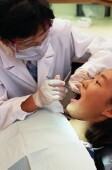
FRIDAY, Feb. 25 (HealthDay News) — Many people have grown accustomed to seeing a physician assistant for minor ailments when their family doctor can’t fit them in.
Now dentistry is creating a similar specialty — a dental therapist who could perform basic dental procedures while freeing up full-fledged dentists to do more complex and invasive procedures, such as extractions and oral surgery.
Not everyone, though, thinks it’s the best way to proceed.
Two states, Alaska and Minnesota, currently allow dental therapists to provide oral care, according to the American Dental Association. Minnesota was the first to license dental therapists, and the University of Minnesota School of Dentistry has become the first college in the nation to offer a dental therapy track.
“We’re only in our second class,” said Dr. Patrick Lloyd, dean of Minnesota’s dentistry school, noting that 33 people applied for 10 slots in the most recent class. “We’re really proud to be the first dental school in the country to have an approved dental therapy program.”
Dental therapists receive two to three years of training in dental procedures. In Minnesota, they study alongside people who are training to become full-fledged dentists, Lloyd said.
“They use the same facilities and the same laboratories and are educated side-by-side to the same standards and level of competency,” the dean said. “The idea is that if they are educated together and learn together, they can better work together.”
By the end of the program, a dental therapist should be able to work in a dentist’s practice performing such procedures as filling cavities and screening for oral cancer. “It’s a first-level set of skills we refer to as primary restorative services,” Lloyd said.
The concept of the dental therapist is beginning to win backers. A two-year study released in late October and funded by the W.K. Kellogg Foundation found that dental therapists in Alaska provide appropriate treatment to patients. The dental therapists successfully prevented children’s tooth decay and competently performed such procedures as filling cavities with amalgam fillings, the study found.
Dental therapists also extended care to people in remote villages who might otherwise have had to wait months or travel hours to have their dental pain treated, according to the study.
However, the concept faces high-level opposition. The American Dental Association has come out against the idea of dental therapists and criticized the Kellogg report, saying it assessed only a limited sample — five therapists and 300 patients — in perhaps the only state in the nation where geography creates a major barrier to access to dental care.
The association has offered up an alternative concept called the community dental health coordinator. This would be a member of the oral health-care team who would mainly serve an educational role, teaching people how to prevent cavities, gum disease and other oral-health problems. Coordinators also would perform basic clinical services, such as dental screenings, fluoride treatments, placement of dental sealants and simple teeth cleanings, and would help patients find a dentist to fill cavities and treat more serious problems.
“We feel this direction is a lot more protective of our patients,” said Dr. Raymond Gist, the association’s president and a dentist from Flint, Mich. “We just have a concern for safety. If a patient has pain, then that patient has a serious dental disease. I feel a licensed, professional dentist should be the person to take care of advanced dental disease.”
The association, a professional society for dentists, is putting its money where its mouth is, funding a pilot training program for a handful of community dental health coordinators. The first group of five graduated in November, and a second group will graduate in the fall.
However, Lloyd and other proponents of dental therapists are concerned that community dental health coordinators would not have enough training and responsibilities to differentiate them from oral hygienists and, therefore, would not be able to extend dental care to people with unmet needs.
“We’ve worked really hard crafting the scope of service so it wouldn’t conflict with dental hygienists,” Lloyd said. “The primary intent is to increase access to care. By delegating some care to the dental therapist, dentists can reduce the cost of care and free themselves up for more complicated procedures.”
More information
The Columbia University College of Dental Medicine has more on dental health.

